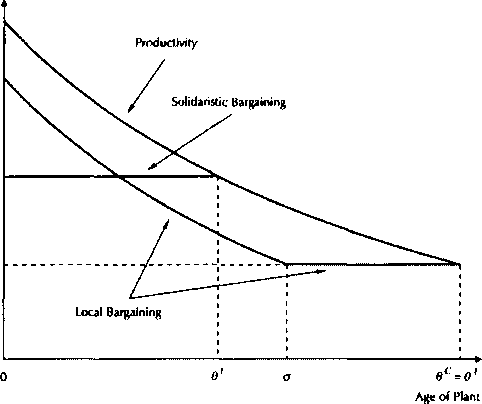Solidaristic Wage Bargaining
83
The Distribution of Wages Across Plants
with Local and Solidartstic Bargaining

in their arguments.If solidaristic bargai-
ning, in fact, increased efficiency, it may have
benefitted groups not usually associated with
egalitarian goals. In particular, we demon-
strate below that Rehn and Meidner's model
implies that the distributional winners from
solidaristic bargaining includes employers as
well as low-skilled workers. Thus, we suggest
that crucial support for solidaristic bargai-
ning came, implicitly, from employers as well
as the central union leadership.
Centralized and
Decentralized Wage-Setting
In order to uncover the implications of the
arguments put forward by Rehn and
Meidner, we focus on a stylized description
of centralized and decentralized wage negoti-
ations in a small, open economy with hetero-
geneous firms. Implicitly, Rehn and Meidner
followed Schumpeter (1942) in attributing
the dynamic of capitalist economies to what
Schumpeter called the "process of creative
destruction" in which existing productive
units are incessantly being dissolved as new
units are inaugurated. Industries expand by
building new plants and contract by scrap-
ping obsolete ones. Entering firms introduce
new techniques that drive the least efficient
of the existing firms out of the market.
When new techniques are embodied in new
plant and equipment, technical progress
entails continual turnover of plants and
firms.
To take the simplest case, consider
an industry in which the price of output is
fixed in world markets, employment is pro-
portional to the number of plants in operati-
on, and the productivity of each plant is
determined by the date it was built.ɔ Newer
plants are more productive than older ones,
but building new plants is costly so older
plants are not immediately replaced. The key
decisions made by firms, in this context, are
when to build new plants and when to scrap
older ones.
Once built, investment costs are
sunk. Firms will keep plants in operation as
long as revenues exceed variable production
costs. Thus, the age of the oldest plant in
operation is given implicitly by the condition
that current profits in the oldest plant in
More intriguing information
1. Clinical Teaching and OSCE in Pediatrics2. TOMOGRAPHIC IMAGE RECONSTRUCTION OF FAN-BEAM PROJECTIONS WITH EQUIDISTANT DETECTORS USING PARTIALLY CONNECTED NEURAL NETWORKS
3. The resources and strategies that 10-11 year old boys use to construct masculinities in the school setting
4. Shifting Identities and Blurring Boundaries: The Emergence of Third Space Professionals in UK Higher Education
5. Qualifying Recital: Lisa Carol Hardaway, flute
6. The Impact of Optimal Tariffs and Taxes on Agglomeration
7. The name is absent
8. Problems of operationalizing the concept of a cost-of-living index
9. The name is absent
10. Anti Microbial Resistance Profile of E. coli isolates From Tropical Free Range Chickens